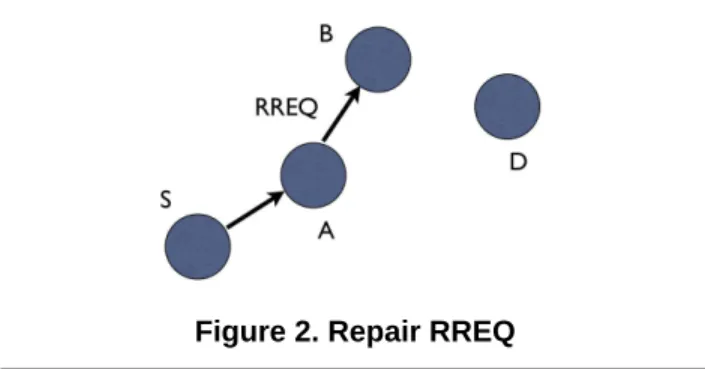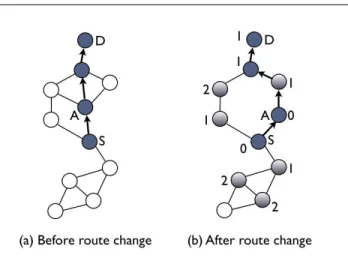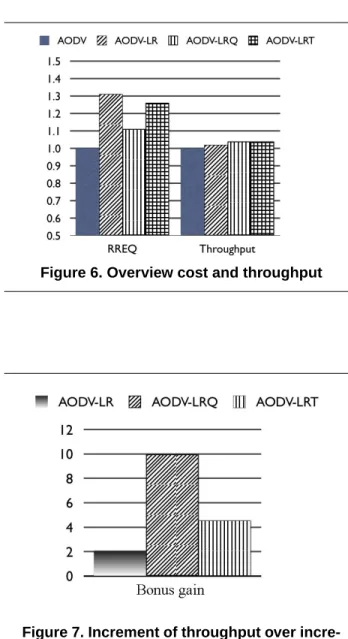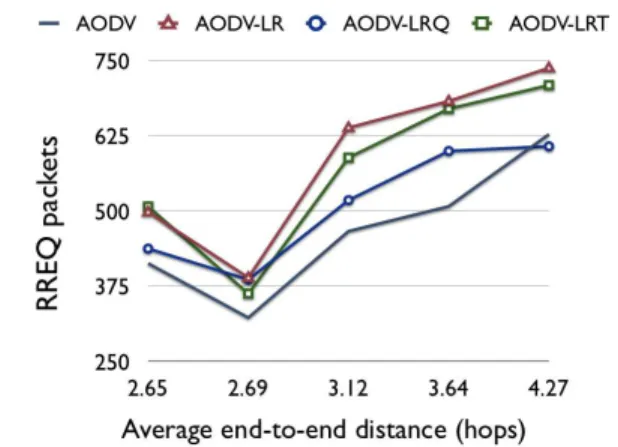行政院國家科學委員會專題研究計畫 期中進度報告
子計畫四:無線感測網路之中介軟體及在社區照護之應用
(1/3)
計畫類別: 整合型計畫
計畫編號: NSC93-2213-E-002-123-
執行期間: 93 年 08 月 01 日至 94 年 07 月 31 日
執行單位: 國立臺灣大學電機工程學系暨研究所
計畫主持人: 王勝德
計畫參與人員: 潘聖文 王浩漢 蔡青峰 莊勝彥 張郁昌 許家祥
報告類型: 精簡報告
處理方式: 本計畫可公開查詢
中 華 民 國 94 年 6 月 1 日
行政院國家科學委員會補助專題研究計畫
□ 成 果 報 告
;
期中進度報告
無線感測網路之關鍵技術及在社區照護之應用-子計畫四:無
線感測網路之中介軟體及在社區照護之應用
計畫類別: □個別型計畫
;
整合型計畫
計畫編號:NSC 93-2213-E-002-123
執行期間: 93年08月01日至94年07月31日
計畫主持人:王勝德
共同主持人:
計畫參與人員:潘聖文 王浩漢 蔡青峰 莊勝彥 張郁昌 許家祥
成果報告類型(依經費核定清單規定繳交):
;
精簡報告 □完整報告
本成果報告包括以下應繳交之附件:
□赴國外出差或研習心得報告一份
□赴大陸地區出差或研習心得報告一份
□出席國際學術會議心得報告及發表之論文各一份
□國際合作研究計畫國外研究報告書一份
處理方式:除產學合作研究計畫、提升產業技術及人才培育研究計畫、列
管計畫及下列情形者外,得立即公開查詢
□涉及專利或其他智慧財產權,
;
一年□二年後可公開查詢
執行單位:國立台灣大學 電機工程學系
中 華 民 國 94 年 05 月 26 日
Local Repair Mechanisms for On-Demand Routing in Mobile Ad hoc Networks
Michael Pan and Sheng–De Wang
Department of Electrical Engineering
National Taiwan University
sdwang@ntu.edu.tw
Abstract
With the dynamic and mobile nature of ad hoc wire-less networks, links may fail due to topological changes by mobile nodes. As the degree of mobility increases, the wire-less network would suffer more link errors. Ad hoc routing protocols that use broadcast to discover routes may be-come inefficient due to frequent failures of intermediate connections in an end-to-end communication. When an in-termediate link breaks, it is beneficial to discover a new route locally without resorting to an end-to-end route dis-covery. Based on the concept of localizing the route request query, we propose an efficient approach to re-pair error links quickly. The approach can apply to the Ad hoc On-demand Distance Vector (AODV) routing pro-tocol. As an enhancement to AODV, the proposed ap-proach leads to two routing protocols, called AODV-LRQ and AODV-LRT, which are aimed to efficiently repair the link errors. To evaluate the effects of the route re-pair, we define a factor, called bonus gain, as the ratio between the throughput increment to the routing over-head increment. Simulation results show that the proposed methods can get high bonus gain, that is, it can main-tain the throughput as well as reduce the routing overheads. keyword: local repair, route request broadcast, mo-bile ad hoc networks, AODV, on-demand routing
1. Introduction
Wireless mobile ad hoc networks (MANET) are in gen-eral characterized by mobile nodes with limited energy, constrained computing capability and absence of any base stations. Mobile nodes communicate to each other by wire-less communication with a limited transmission range and they are usually equipped with omnidirectional antenna. This results in multi-hop transmissions, which is quite dif-ferent from cellular wireless networks. In this case, a source
node may need intermediate nodes to forward packets to the destination node.
On-demand ad hoc routing protocols typically make use of request query broadcast to discover routes when a source-to-destination communication is needed. Among them, Ad hoc On-demand Distance Vector (AODV) and Dynamic Source Routing (DSR) [3] are the two most important rout-ing methods. They are both on-demand reactive routrout-ing pro-tocols. AODV is based on the distance-vector method [4], while DSR records all intermediate nodes in each source-destination pair. Due to the ever changing environment of MANET, the design of routing protocols is challenging and the resultant protocols are tending to be adaptive and dy-namic. Mobility prediction is an approach to modeling the behavior of MANET and is aimed to enhance the reliable communication. In [5], the author uses a prediction table with pre-defined speed-role and some landmarks to predict mobility in the way-point graph [7]. However, in [6], the au-thor predicts a node is stable or not by simply sending bea-cons to neighbor nodes. According to the address resolu-tion protocol, we know that when a mobile node in dor-mancy would receive more beacons than it is in moving.
There are three types of important packets in AODV, that is, RREQ, RREP and RERR packets. The RREQ packet means a route request packet, which is sent when a node wants to construct a path to destination or when a link er-ror occurs in the node. The RREP packet means a route re-ply, which is sent when it receives the RREQ packet and a route to destination has been found. The RERR packet means a route error packet, which is sent to the originator of the packet hop by hop when a node can’t find a route to des-tination and every intermediate node that is in the previous successful path from the source to the current node will for-ward the RERR packet until the RERR packet is sent back to the source node of the packet.
AODV broadcasts a RREQ packet to the neighbors by the expanding ring search method, where an iterated incre-ment of TTL (time-to-live) in the RREQ packet is used to discover the route to the destination. For example, a node will first send the RREQ packet with TTL=1 and then send
RREQ packets with TTL=2 if it did not find a route to des-tination in the previous try. Finally the node will keep the TTL value until the end-to-end communication is finished.
Link errors usually happen in mobile ad hoc networks and they are also inevitable. One way to reduce the effects of link errors is to repair routes when link errors occur. Our route repair concepts are based on the localizing route re-quest flooding and are aimed to reduce the control over-heads as well as to keep the throughput in a transport layer protocol such as TCP. As can be seen from [14, 15, 16], al-though AODV is an adaptable routing protocol in the high mobility environment, it may incurs two much communi-cation overhead when link errors happened. In this case, the RERR packets and RREQ packets will be triggered fre-quently by intermediate nodes involved in the route discov-ery. In the following, we will refer the communication over-head to the RREQ packets present in the network traffic.
The current implementation of [1] often incorporates a version of the local repair mechanism in AODV. However, the protocol has room to improve in the reduction of con-trol overheads. In this paper, the goal is to reduce the concon-trol overheads as well as to keep the communication through-put under the TCP transport layer protocol. The remainder of this paper is organized as follows. Section 2 describes the related work. In Section 3 we will discuss the problems we concerned and propose the solution approach. In Sec-tion 4 we present our simulaSec-tion study and experimental re-sults. In Section 5 conclusions are included.
2. Related Work
A local repair procedure in AODV in initiated when nodes suffer link errors. The procedure broadcasts a RREQ (route request) packet to find a new route to the packet’s des-tination as shown in Figure 2 instead of returning the error message to the source node of the packet as shown in Fig-ure 1.
Figure 1. Link Error Occurs
Existing approaches [8] include a preemptive routing method that make use of proactive mechanisms to detect
Figure 2. Repair RREQ
the link weakening so that a reliable route can be cho-sen before the link breaks. In the preemptive approach, a node that detects a weakening link from one of it’s neigh-bors will broadcast a Handoff packet with TTL=1 to its neighbors. On receiving Handoff packet, each node will de-termine if any of its neighbors has links with more sig-nal power than the current links. The information about link signal strength is kept by Neighbour Power List (NPL) and Power Difference Table (PDT). NPL records all neigh-bors’ energy and PDT records the power difference between every two nodes in neighbors. As we can see, this approach costs a lot in storage for link power information.
Query localization techniques [2] are based on the con-cept of time locality. The time locality is kept track in a his-tory path node list, Pold. Two kinds of repair mechanisms are discussed, that is, Exploiting Path Locality (EPL) and
Exploiting Node Locality (ENL). In EPL, a node will
broad-cast a query with a counter and the accumulated path (P) to at most k nodes not in Pold. Figure 3 illustrates the above concept. In Figure 3(b), we can see that the number beside the node indicates the counter value. A node in ENL sends a query with Poldand a counter to neighbors when link er-ror occurs. When a node receives a query, the nodes in ENL will drop the query it received if the counter in the query ex-ceeds a threshold value k. The counter (initialized to zero) in the query packet will be incremented by a node that is not in Pold, otherwise the value of the counter will be kept. We set the ENL process with k=2 in the example of Fig-ure 3.
In [9], a reliable route selection algorithm is proposed based on global positioning systems (GPS). Two zones are defined, a stable zone and a caution zone. A node will at-tempt to deliver RREQ packets to the other node in a node-pair when they are both in each other’s stable zone. The key problem is how to define stable zone’s radius. The approach in [9] is making use of GPS to get the position and speed of each node and thus define the radius of stable zone accord-ing the speeds of nodes.
A route discovery method called relative distance micro-discovery (RDMD) is proposed in [10]. The method is based
on the estimation of relative distance between two ends and uses the value in TTL field in the RREQ packet. The rel-ative distance is calculated by an iterated algorithm based on a specific route metric, velocity and last update time of nodes to localized the discovery range and assumes the ve-locity of the node is known. A similar and simple approach is also proposed in [11], where a two-hop broadcast is used to repair the link break.
Figure 3. Illustration of the path locality prin-ciple with k=2
In this paper, we will focus on improving the current im-plementation of local repair in AODV and keep the cost ef-fective as well. The metric we will use to evaluate the lo-cal repair mechanisms is based on the number of success-fully transmitted packets in a period. The cost we consider is the number of route request packets (RREQ) in the network traffic involved. To taking both the factors into account, we define a term called bonus gain to capture the concept.
We will apply the proposed protocol to AODV. Routing protocols in MANET has been widely investigated in litera-ture such as [14], [15] and [16]. In [14], it shows that AODV has better performance than DSR in high mobility environ-ments, and DSR has better performance than AODV-LL as described in [15]. AODV-LL is a variant of AODV with pe-riodically broadcasting of Hello messages. AODV-LL is ex-pected to have more overheads than AODV. This is also mentioned in [15]. As the result presented in [14], AODV will perform well in high mobility environments.
3. Route Repair
We conduct simple experiments to test the performance of the current implementation AODV-LR [13] of local re-pair method in NS-2 [12]. The experiments use default TCP,
transport layer protocol to send packets in a period of 300 seconds in NS-2 [12] simulator, and the network topol-ogy is consisted of 50 nodes randomly located in 1600m x 500m area. In order to simulate a high mobility envi-ronment, the maximum speed of each node is set to be 40m/s and the pause time of each node is 75 seconds. In AODV-LR, approximately 28.7% redundant RREQ (Route Request) packets were sent, but only 1.8% extra success-fully transmitted packets are obtained.
Figure 4. Cost vs. Performance
Figure 4 summarizes the results, where the left bar chart shows the normalized RREQ packets of AODV-LR with re-spect to AODV and the right bar chart shows the normal-ized throughput of AODV-LR to AODV. We can see that communication overheads increase so much as compared the throughput gained. Inspired by this observation, we are looking for an improved protocol to reduce the overheads and to keep the throughput as well.
In order to reduce the cost (RREQ packets) in AODV-LR, we can decrease breadth or depth of the extent to which the repair mechanism applies in AODV-LR. Decreasing the depth of repair mechanisms means to limit the number of times a node is allowed to forward the repair route request. we can let each node carry out the route repair k times in some period T. Decreasing the breadth of the repair mecha-nisms means we can limit TTL=m in RREQ packets to lo-calize the repair RREQs. The breadth and the depth con-straints can apply in the same time to further localize the route request packets. In the following, will propose the re-pair quota and limited TTL approach based on the breadth and the depth constraints, respectively.
In controlling the breadth, each node has a repair quota (RQ) which is initialized to k in the start of a period. When a link error occurs, the node will determine if its re-pair quota is greater than 0. If the node’s RQ is greater than 0, the node is allowed to carry out route repair opera-tions and then decrease k by one. In the other hand, the node
will drop the RREQ packet received and send the RERR (route error) packet to the source node. A timer will pe-riodically reset each node’s RQ to k as explained in Fig-ure 5. We call this method AODV-LRQ.
Pseudo codes :
redo number=k REPAIR PERIOD=T bonus()
route link layer failed(){ . . .
if ( the broken link is closer to the destination than source && redo number > 0 ){
local route repair();
redo number−−;
} . . . }
void bonus() {
int slice=CURRENT TIME / REPAIR PERIOD; if slice > 0 && slice > prev number {
redo number=REPAIR TIMES; prev number=slice;
} }
We denotes all variables with bold face above. Vari-able redo number represents the repair quota. VariVari-able
RE-PAIR TIMES denotes the number of repair operations will
be performed in each REPAIR PERIOD period. Func-tion bonus() is a trigger timer that periodically resets the
redo number. We divided the time by REPAIR PERIOD
and then we save time slice numbers in the variable, slice in function bonus(). The previous time slice number will be saved in the variable, prev number and we will check if current time slice number, slice, is larger than the previous time slice number prev number in the function bonus() be-fore function local route repair is called. If the current time slice number is larger than the previous time slice number, the route repair operation is performed; otherwise the node will send a RERR packet to the source of the packet it just received like AODV without local repair does.
To evaluate the effects of the breadth and the depth con-straints, we choose to implement a TTL limited route re-pair algorithm, called AODV-LRT. As compared with the method of Exploiting Node Locality (ENL) pro-posed in [2], AODV-LRT only limits the depth of the route request propagation without distinguishing be-tween the nodes in old path list or the other new nodes. The following pseudo codes set the TTL to an appropriate
num-Figure 5. Repair mechanism with Timer and Repair Quota k
ber m.
Pseudo codes : In sendRequest(){ . . .
if this node is in repair set TTL to m . . .
}
4. Simulations
Network Simulator version 2 (NS-2) [12] is a well-known simulator. We can do either wired or wireless net-work simulations in NS-2. We simulated basic AODV (AODV), AODV with local repair (AODV-LR), AODV with repair quota (AODV-LRQ) and AODV with lim-ited TTL (AODV-LRT). We will discuss overall cost and performance of the four methods mentioned.
In our experiment we generated a wireless network con-sisted of 50 nodes randomly placed in 1600m x 500m area and the simulation duration is 300 seconds. Each node’s moving speed does not exceed 40m/s with 75 seconds pause time. Dependent on the network size, the parameters can be set as follows: k=1 and T=300 in AODC-LRQ; m=3 in AODV-LRT, since a packet with TTL=3 can go through half of the simulated network topology. During the simulation, total 20000 packets are transmitted using the TCP protocol.
4.1. Overview Evaluation
We evaluated the communication cost and the through-put of each method. The cost means the number of total
RREQ packets received in a period, and total RREQ pack-ets are the summation of RREQ packpack-ets in all nodes. The throughput means the number of total end-to-end success-fully transmitted packets in the given period. To both con-sider the two factors, we define a bonus gain as the ratio be-tween the throughput increment to the routing overhead in-crement. The performance of basic AODV will be used as a base in comparison. So the bonus gain will be computed as:
bonus gain(R) = RRREQ−AODVRREQRtp−AODVtp (1)
where R is a routing method and the subscripts tp and RREQ stand for the throughtput and the number of RREQ packets, respectively. As we can see in Figure 6, appar-ently AODV-LRQ successfully reduced many RREQ pack-ets when errors occur without degrading the throughput. In Figure 6 it seems that AODV-LRT performed almost as well as AODV-LRQ in the metric of communication overheads in terms of number of RREQ packets, but after taking a look at the bonus gain as shown Figure 7 we found AODV-LRQ performed at least two folds better than AODV-LRT did. Furthermore, in the metric of bonus gain AODV-LRT performed two times better than AODV-LR. Overall, in terms of bonus gain of AODV-LRQ is five times better than AODV-LR. From this observation, decreasing the breadth to which the repair mechanism is applied is better than de-creasing the depth.
4.2. Detailed Evaluation
In detailed evaluation of the performance, we want to take into consideration of the end-to-end distances in the communication. Average number hops is the average num-ber of route length from source to destination that was gen-erated by NS-2 in our experiment. We classified all end-to-end transmissions by the successfully transmitted packet of AODV without local repairs and then compute the average of the hop number of each end-to-end transmission. The av-erage number of hops could be used to model the relative distance of any pair of nodes. A small relative distance may represent they have a low relative speed or they are close enough to each other in the network.
As for the control overheads, in Figure 8 we can see both AODV-LRQ and AODV-LRT have less RREQ packets than AODV-LR, and AODV-LRQ has less RREQ packets than AODV-LRT in most situations. From Figure 8 we know if we want to reduce more RREQ packets we should better limit repair quota in each node or set TTL less than 3. As for the throughput, in Figure 9, we can see that more through-put can be obtained with local repairs in larger relative dis-tances from 3.64 to 2.69 hops. In addition, if the relative distance is even more larger such as 4.27 hops, all
proto-cols perform in the same way in this case since the no pro-tocols can help in such fast changing environment.
It is interesting to compare the performances between AODV-LRQ and AODV-LRT, which are based on the con-straints of breadth and depth, respectively. In terms of suc-cessfully transmitted packtes (i.e., the metric of through-put), AODV-LRQ performed well in large relative distances (>=3.12 hops) and AODV-LRT did better in small relative distances (<=2.69 hops), as can be seen from Figure 10. However, in terms of bonus gain, AODV-LRQ is better than AODV-LRT. This means that in general AODV-LRQ can have good cost effective results.
Figure 6. Overview cost and throughput
Figure 7. Increment of throughput over incre-ment of cost
Figure 8. Illustration of overheads in RREQ packets vs. relative distances
Figure 9. Illustration of the throughput vs. rel-ative distances
5. Conclusion
We have proposed a local repair approach to enhance the performance of on-demand ad hoc routing protocols. The concept of the proposed approach is based on the constraints of route repair requests in both the breadth and depth, which lead to the two routing protocols, called AODV-LRQ and AODV-LRT. To evaluate the effects of the route repair meth-ods, we define a factor, called bonus gain, as the ratio be-tween the throughput increment to the routing overhead in-crement. Simulation results show that the proposed meth-ods can get high bonus gain as compared with the basic AODV-LR. In addition, we also found that the constraint in the breadth of route request floods can get better per-formance in most cases than the depth constraints. Actu-ally, The breadth and the depth constraints can apply in the same time to further localize the route request packets. If we
Figure 10. Detailed AODV-LRQ vs. AODV-LRT about transmitted packets
want to design a repair mechanism to suit our needs, we can choose the method based on our concept of constraints of the breadth and the depth to which the route request broad-cast is applied.
References
[1] C. E. Perkins and E. M. Royer, Ad-hoc On-demand Distance
Vector Routing, In Proceedings of the 2nd IEEE Workshop
on Mobile Computing Systems and Applications, pages 90-100, Feb 1999.
[2] R. Castaeda, S. R. Das and M. K. Marina, Query localization
techniques for on-demand routing protocols in ad hoc net-works, Wireless Netnet-works, v.8 n.2/3, pages 137-151,
March-May 2002.
[3] D. B. Johnson and D. A. Maltz, Dynamic Source Routing in
Ad hoc Wireless Networks, Mobile Computing, 1994.
[4] C. Perkins and P. Bhagwat, Highly dynamic
destination-sequenced distance-vector routing (DSDV) for mobile com-puters, in ACM SIGCOMM’94 Conference on
Communica-tions Architectures, Protocols and ApplicaCommunica-tions, pages 234-244, 1994.
[5] Jian Tang, Guoliang Xue and Weiyi Zhang, Reliable Routing
in Mobile Ad Hoc Networks Based on Mobility Prediction,
Mobile Ad-hoc and Sensor Systems, pages 466-474, 2004 [6] Chai-Keong Toh, Associativity-Based Routing for Ad Hoc
Mobile Networks, Wireless Personal Communications: An
International Journal, v.4 n.2, pages 103-139, March 1997. [7] J.-Y. Le Boudec and M. Vojnovic. The Random
Trip Mobility Model, Last update: Nov 12, 2004.
http://ica1www.epfl.ch/RandomTrip/
[8] P. Srinath, P. Abhilash, I. Sridhar, Router Handoff: A
Pre-emptive Route Repair strategy for AODV, IEEE Intl.
Confer-ence on Personal Wireless Computing, New Delhi, Decem-ber 2002.
[9] W.-I. Kim, D.-H. Kwon, and Y.-J. Suh, A Reliable Route
Mo-bile Ad-hoc Networks, Proceedings of the IEEE International
Conference on Communications (ICC ’2001), June 2001. [10] G. Aggelou and R. Tafazolli, RDMAR: A
Bandwidth-Efficient Routing Protocol for Mobile Ad Hoc Networks,
Pro-ceedings of the ACM International Workshop on Wireless Mobile Multimedia (WoWMoM), Seattle, WA, pp. 26-33, August 1999.
[11] 2003 G.P.Liu, PATCH: A novel Local Recovery Mechanism
for Mobile Ad-hoc Networks,IEEE VTC, 2003
[12] The Network Simulator - ns-2, http://www.isi.edu/nsnam/ns/ [13] AdHoc@UU : ImplementationPortal, Last updated: Feb 19,
2005. http://core.it.uu.se/AdHoc/ImplementationPortal [14] C. Perkins, E.M. Royer, S.R. Das, and M.K. Marina,
Per-formance Comparison of Two On-demand Routing Proto-cols for Ad Hoc Networks, IEEE Personal Communications,
pages 16-28, Feb. 2001.
[15] J. Broch, D.A. Maltz, D.B. Johnson, A performance
compar-ison of multi-hop wireless ad hoc network routing protocols,
ACM MobiCom, pages 85-97, 1998.
[16] T. D. Dyer , R. V. Boppana, A comparison of TCP
perfor-mance over three routing protocols for mobile ad hoc net-works, Proceedings of the 2nd ACM international
sympo-sium on Mobile ad hoc networking & computing, October 04-05, 2001, Long Beach, CA, USA



